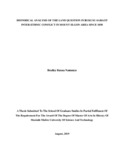| dc.description.abstract | Ethnic conflicts have been witnessed world over; different communities fight each other over territorial boundaries, limited natural resources and political supremacy. This worrying trend disturbs livelihoods, access to social amenities and affects local and international economies. As a limited resource, with cultural and economic value, land has generated inter-ethnic conflicts across the world. In Kenya communities like the Maasai and Kipsigis have recently fought over land and cattle. The Pokomo and Oromo have had a history of land conflict in the Tana River Delta. In the recent past, the Gabbra and Dassenetch communities of Marsabit County have fought over grazing land. It is against this backdrop that this study examined the historical analysis of the land question in Bukusu-Sabaot inter-ethnic conflict in Mt. Elgon area since 1850. Specific objectives of the study are: to assess the relationship between the Bukusu-Sabaot during the pre-colonial period; to examine the Bukusu-Sabaot relationship in the colonial period and; to analyse the land question in the post-independence Bukusu-Sabaot conflict. This study was grounded on instrumentalists and constructivists theories of ethnic identity. Barth argued that ethnicity is a product of social process rather than cultural forces. Constructivist argues that ethnic identity is the latest invention in Africa created by colonialists and missionary agents. Instrumentalists on the other hand, view ethnicity as a tool by the elites as a means to achieve certain objectives. The finding of this study revealed that the land question in Mt. Elgon area can be traced to the conflict of migration and settlement between the Bukusu and Sabaot communities in Mt. Elgon area. The land question was also perpetuated by the both the colonial and post-colonial governments through their land and general policies. The study in addition found that socio-political and economic features of both the Bukusu and Sabaots reinforced the land conflict in Mt. Elgon area. The study further found that ethnicity, gender dimensions, politics, elites and infiltration of firearms in Mt. Elgon area fuelled the Bukusu-Sabaot inter-ethnic land conflict in Mt. Elgon area. The study recommended that epicentres of conflict should be mapped out and intervention measures concentrated in such areas. The study recommends that cultural relativity should be emphasised, and that conflicts actors should be at the centre of conflict mitigation. The study also recommended that gender related pressure regarding land ownership should be dropped and the government should take disarmament exercise seriously in Mt. Elgon area. The study further recommended that there is need to ease pressure on land by establishing alternative sources of livelihood. The study also concludes that traditional methods of conflict resolution should be fused with religious conflict intervention methods and other modern mitigation methods to avert the conflict. | en_US |

